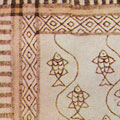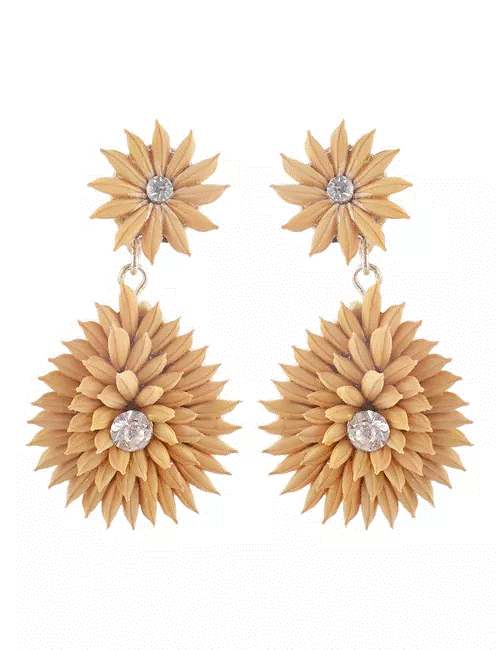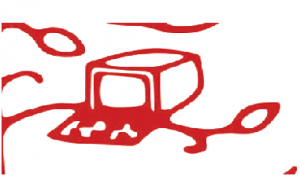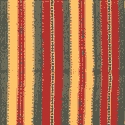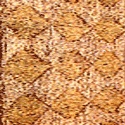The folded mat used by farmers and workers is an ingenuous umbrella that provides complete protection from the rain; unlike the conventional umbrella, it allows both the hands to remain free to continue work. This unusual and utilitarian farmer's umbrella is attached to a string that is slung over the forehead as a support. Made in bamboo the waterproofing is done with the leaves of the camel foot climber bhorla (Bauhinia Vahlia), which is sandwiched between the two layers of open weave bamboo sheets.
Farrukhabad cotton print products include scarves, stoles, fabric, sarees, gents’ mufflers, shawls, bedspreads, cushion covers, curtains, cushions with long stripes, etc. These items are profusely decorated hand-block printed designs. It is believed that the skill of cotton printing originated in Farrukhabad almost a thousand years ago. The printing on cotton and silk is done with hand-blocks; the design is first carved on blocks of wood and then stamped on to the cloth. One particular pattern, the tree of life, is the main characteristic of this artistic work. It is also one of the most important foreign exchange earners and the district occupies a prominent place on the export map of the world for it silk and cotton prints. The artisans of Farrukhabad practice two types of printing—block-printing and screen-printing. Previously, the artisans used natural dyes, but at present they use both vegetable and synthetic dyes. Earlier, potatoes were used as blocks for printing with vegetable and natural dyes.
The craft of making felt products is practiced widely in Rajasthan. Felt, made by compressing wool using water and soap is used to create various items such as namda, shoes, bags, rope belts and buttons etc. in Jaipur, Tonk and Malpura. Wool of cream, brown, and black color is sourced from Shekhawati, Beawar and Jodhpur while finer quality wool is sourced from Sikar and Kashmir. Tools such as peental which is used to open fibres, pheda which is used to spread fibres, chaapa- pressing tool and winnowing machine are used for the process. Tools such as tool used to open fibres called peental, tool used to spread fibres called pheda, pressing tool called chaapa and winnowing machine are used for the production process.
Headgear and footwear has traditionally been made of felt material in Nepal. The felt is either made completely of wool or of a combination of wool and cotton mixed in the required proportion.
Gauri Puja is an important Hindu festival and is celebrated in all parts of Maharashtra. Decorative Gauri heads in traditional style made from brass are cast in Pune. Other types of Gauri heads, are made with wood and papier mache. The making of clay toys is a very old Indian tradition and is usually associated with festivals and celebrations. The very impermanence of clay objects is an important aspect of the continuity of regeneration and creation. Maharashtra has a very strong tradition of creating figures of deities on ceremonial and auspicious occasions. Images of Ganesh are made all over Maharashtra and then carried in procession and worshipped after which they are immersed in water.
People have been using botanical seeds strung together as ornaments since centuries. Donning wild beads was a signifier of wealth, sentiments, society and medicinal aids. India has a rich culture of such ornaments being donned by the wealthy and the members of the aristocracy. South Indian Tamil queens were also known to wear ornaments made from seeds and plant fiber to express their royal heritage. These kinds of jewellery are also famous in tribal communities and are considered of high ornate value.
Recent contemporary times have adopted plant and seed fiber made jewellery as a statement of fashion with a social motive of promoting the cultivation of plants and sustainable utilization of nature by civilization. It is a unique way to create avenues for botanical conservation and livelihood sustenance for the local community that lives therein with.
The collection of these tropical and wild plants is mapped from the geographically privileged areas such as the Eastern Ghats, Western Ghats and interior villages of southern India.
These jewels have a wide range of aromatic essences and they all flourish in natural colors. These jewels have been designed by botanists, conservationists and natural dwellers of the forest laden areas. Necklaces, earrings, pendants, and bracelets are just a few of the many styles of ornaments that can be made from these natural materials.
| Clay roof tiles are used in most parts of the country, except where strong winds and cyclones, and/or snow, are frequent. Good quality tiles, appropriately overlapped, are waterproof in ordinary climatic situations. Clay tile production is an age-old cottage industry in several areas, specially rural zones, with potters making these tiles as part of their tradition repertoire of products: pots, storage and cooking vessels, images of deities, lamps, figurines, bird and animal shapes, and toys. Clay roof tiles often have a figure on each tile - birds, squirrels, monkeys and mice being the most common. This tradition originated in the need to scare away wild animals and these animals perched on tiles act somewhat in the nature of scarecrows. The 'country' roof clay tiles made by the Sonepur potters are long half cylinders in shape. |
| STEPS | |
 |
|
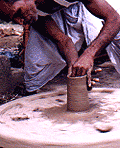 |
|
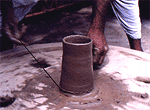 |
|
 |
|
 |
|
 |
|
 |
|
 |
|
 |
|
 |
|
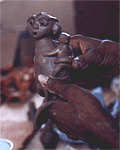 |
|
 |
|
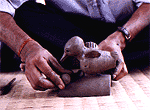 |
|
 |
|
 |
|
The fishermen of Pokhara from the podas and dyolas castes craft their own nets for fishing out of the stems of the stinging nettle (sisnurtica dioicaI: family - urticaceae) found in the high altitudes of the mountains to the north of Pokhara in west Nepal. These hardy and strong nets are used by the fishermen to catch fish in small ponds and rivers. Though primitive, these highly durable nets have many advantages as they give many years of service since they are easily repairable; they have a wide spreading range when cast and the colour of the net provides easy camouflage against the water - unlike the shining nylon nets these do not frighten the fish.
In the ancient times, painters and designers created a range of forms and designs on cloth for religious and national ceremonies. Religious paintings on cloth were known as petikada; the inspiration behind them ranged from painted ceilings to the walls of temples. Preserved specimens of cloth paintings indicate the use of bright colours - red, yellow, and white. The topics selected are presented in a continuous narrative form resembling mural paintings.
Bihar has a tradition of carpet-weaving since the Buddhist and Mauryan era. The carpet industry found royal patronage about 300 ago, during the Mughal period and it is since then that pile carpets started being made here. Carpets with traditional Indo-Persian designs and floral and geometric motifs are made here. Cotton dhurries are also made made. Due to the hot Indian climate they are used widely. They can be patterned in a single colour or they can be multicoloured. The patterns include simple lines, geometric designs, and symmetric motifs.
Floor coverings made in Haryana have rich hues and weaves in designs that range from floral and geometrical to human and animal forms. The materials used include cotton, jute, and wool, either individually or combined with each other.
Bihar has a tradition of carpet-weaving since the Buddhist and Mauryan era. The carpet industry found royal patronage about 300 ago, during the Mughal period and it is since then that pile carpets started being made here. Carpets with traditional Indo-Persian designs and floral and geometric motifs are made here. Cotton dhurries are also made made. Due to the hot Indian climate they are used widely. They can be patterned in a single colour or they can be multicoloured. The patterns include simple lines, geometric designs, and symmetric motifs.
Dhurries or floor coverings are made of cotton and they are woven all over India, with Calicut being the main centre in Kerala. Both single colours as well as mixed colours are used. The patterns include simple lines, geometrical designs, and other symmetrical motifs. The combinations are of wool, silk, and coir.
The production technique of forging the hollow metal utensils crafted from brass and copper sheets is an ancient tradition in Nepal. The technique has been handed down from generation to generation among hereditary tamrakar/tamot craftsmen.
- First the opening of the gagri is cut out of a brass sheet into two shapes. The part forming the neck of the gagri is bent upwards to form a cylinder and the edges are soldered together. The bottom part is shaped out of a circular brass sheet that is 16"-18" in diameter. This circular sheet is hammered on stone anvils (ga) firmly sunk into the workshop floor. This stone mould helps to bring the bottom of the gagri into the desired shape after a good deal of beating and hammering.
- The middle of the gagri is constructed through a similar process of beating and hammering. All the three main parts of the water pot are thus shaped after a good deal of labour.
- To join the three parts all the edges to be joined together are cut out in the shape of teeth 0.5 to 1 inch apart. Next, these tooth like edges are made to fit one into the other with a gentle beating so that they make a very tight fit.
- To weld the parts a ratio of 2: 1 of brass and zinc is melted together to prepare the flux. The flux in a powdered form mixed with borax (suhag) is applied over the joints of the tooth like seams. The gagri is then slowly heated over the fire so that the flux melts and fills up the pores between the tooth joints - with gentle beating the gaps between the joints are made air-tight. The same process is repeated while joining the other two parts.
- After welding together, the edges continue to look rough until they are rubbed with a sharp file. At this stage, the gagri looks dirty and black. For cleansing it is dipped into a sour liquid like a citrus fruit acid (chuk), or in the waste liquor of a brewery (kat/ ajika) for 2 to 3 days. The alternate process is to smear the pot with a dilute acid solution. Some craftsmen in Lalitpur have substituted sulphuric acid for the traditional old brewery waste; at Pokhara and Tansen, however, the craftsmen continue to follow the old method of dipping the utensils in kat/ajika. The gagri is then scoured with the fine sand and clay dust till the metal shines through.
- The gagri is finally beaten all over with a small pointed hammer till its outer surface is embellished with tiny shiny spots. The more pointed the hammer, the more shiny the spots. This process is called dam halne.

